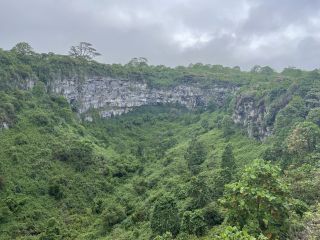Environment
Why I Prescribe Nature
Getting outside is good for many aspects of mental health.
Posted January 19, 2024 Reviewed by Lybi Ma
Key points
- There is increasing evidence that being in nature is good for your mental health.
- Studies show nature can help improve cognitive function, enhance well-being, and even promote kindness.
- Mental health professionals must emphasize the importance of being in nature.
- We owe it to our children and ourselves to protect and experience our natural resources.

At Georgetown University School of Medicine, I run a wellness group for first-year psychiatry residents. I use a lot of mindfulness meditation, and we process the stressors of becoming a young psychiatrist. On a particularly nice day, I suggested that we might go outside for the 50-minute wellness didactic, and they agreed. I had no agenda to speak of, so we simply walked down a nature trail behind our outpatient clinic. In about 10 minutes, we were in a valley, with only the occasional dog walker or jogger. In the heart of Washington, DC, we were firmly “in nature.”
The results were fast and powerful. The residents were laughing and pointing out particular trees. At one point, we came across a little stream, so each of us had to find some stepping stones or risk getting wet. It was great fun. Thirty minutes later, we were back in the clinic, refreshed and ready to see patients. What happened? Why had our time outside made such a difference?
Spurred on by necessity due to the pandemic, mental health professionals now have a better understanding of the benefits of being in nature. Based on this experience, I did a deeper dive into how nature may play a role in promoting the well-being of my patients, our children, and ourselves.
As Covid-19 began pushing people outside, I heard more about green and blue spaces. They are exactly as they sound, green space is anything with grass or trees, and blue spaces are any natural scene involving water. It turns out, both are healthy for us in some significant ways. Here are just a few:
Cognitive Benefits. Simply put, being in nature is good for your brain. In an urban environment, we have to keep our wits about us. We have to look out for that bicycle, avoid that car, and watch for loose sidewalk grates. Stressful. In nature, we have no such distractions. Or rather, there are distractions everywhere in nature; they are just not generally stressful ones. With this dichotomy in mind, research suggests that walking in nature improved directed-attention cognitive abilities. Other studies in this area showed a positive impact on nature on children’s school performance when they are exposed to the green space of nature.
Happiness and Well-Being. Studies have found that being in nature can promote a subjective sense of well-being and happiness. This is what I saw at work with our psychiatry residents. A short walk in the woods seemed to bring down their stress level, better preparing them to take on the rest of their challenging day.
Improved Social Interactions. This one is less intuitive, at least to me. Studies have shown that exposure to nature can enhance social interactions and promote pro-social behavior. Yes, there is evidence that nature can make us kinder and better friends.
Less Mental Illness. A longitudinal study in Denmark found that its citizens who grew up with exposure to more green space had a reduced risk of many psychiatric disorders, such as depression, schizophrenia, and eating disorders later in life. Thus, growing up with natural features nearby is good for children, while conversely, the lack of green space puts them more at risk.
With the evidence of the healing aspects of nature mounting year by year, it is becoming clearer that it must be an integral part of our lives for optimal health. Mental health providers must consider incorporating it into their treatment plans. As a psychologist, I do not prescribe medications, but I do prescribe nature. Parents and teachers must allow for breaks from screens and encourage the children in their charge to get outside. City planners, school boards, and architects need to prioritize green space in new construction projects. Finally, we all owe it to ourselves to protect and respect the natural world around us.
References
Berman MG, Jonides J, Kaplan S. The cognitive benefits of interacting with nature. Psychol Sci. 2008 Dec;19(12):1207-12. doi: 10.1111/\j.1467-9280.2008.02225.x. PMID: 19121124.
Bratman, G. N., Anderson, C. B., Berman, M. G., Cochran, B., de Vries, S., Flanders, J., Folke, C., Frumkin, H., Gross, J. J., Hartig, T., Kahn, P. H., Kuo, M., Lawler, J. J., Levin, P. S., Lindahl, T., Meyer-Lindenberg, A., Mitchell, R., Ouyang, Z., Roe, J., Daily, G. C. (2019). Nature and mental health: An ecosystem service perspective. Science Advances, 5(7). https://doi.org/10.1126/sciadv.aax0903.
Dadvand P, Nieuwenhuijsen MJ, Esnaola M, Forns J, Basagaña X, Alvarez-Pedrerol M, Rivas I, López-Vicente M, De Castro Pascual M, Su J, Jerrett M, Querol X, Sunyer J. Green spaces and cognitive development in primary schoolchildren. Proc Natl Acad Sci U S A. 2015 Jun 30;112(26):7937-42. doi: 10.1073/pnas.1503402112. Epub 2015 Jun 15. PMID: 26080420; PMCID: PMC4491800.
Engemann K, Pedersen CB, Arge L, Tsirogiannis C, Mortensen PB, Svenning JC. Residential green space in childhood is associated with lower risk of psychiatric disorders from adolescence into adulthood. Proc Natl Acad Sci U S A. 2019 Mar 12;116(11):5188-5193. doi: 10.1073/pnas.1807504116. Epub 2019 Feb 25. PMID: 30804178; PMCID: PMC6421415.
Goldy, S.P., Piff, P.K., (2020). Toward a social ecology of prosociality: Why, when, and where nature enhances social connection. Current Opinion in Psychology, 32, 27-31.


